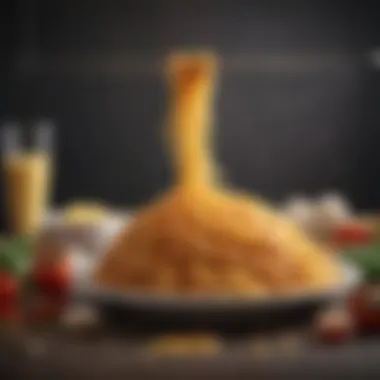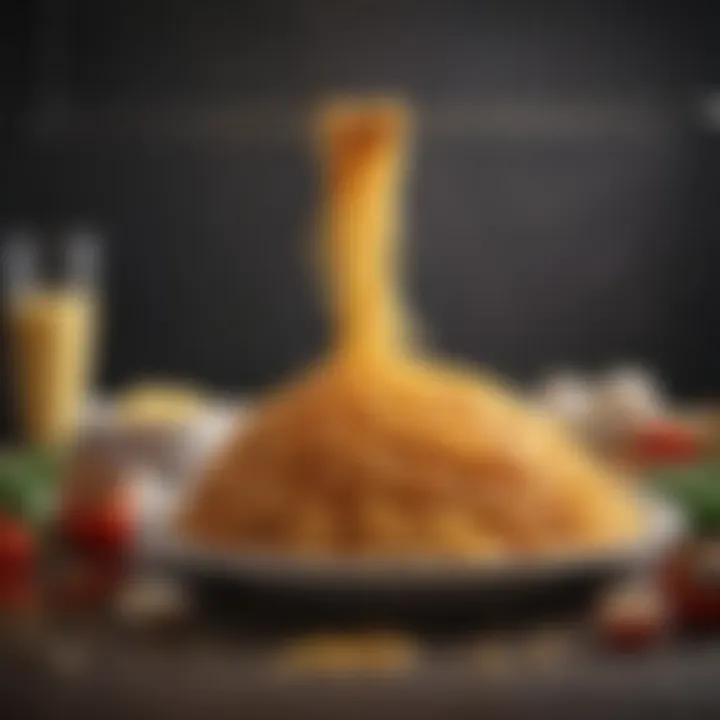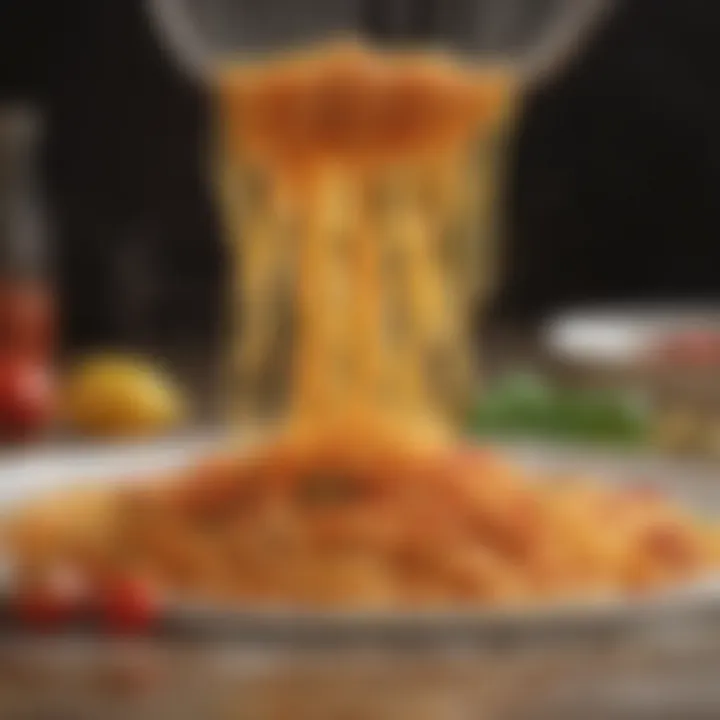Mastering Spaghetti Measurements for Perfect Pasta


Intro
Measuring spaghetti noodles might sound mundane, yet it holds significant weight in the culinary world. Getting just the right amount impacts not only the meal’s enjoyment but also the culinary experience as a whole. Discerning cooks know that the devil is in the details, and that detail often comes down to precise noodles. Understanding how much spaghetti to cook can mean the difference between generous portions and an unwanted wastage of food.
Think about it: when hosting, you want your guests to savor every bite, not leave them hunting for leftovers. Thus, a delicate balance of science and art begins when gauging the amount of noodles. In this article, we will illustrate the various methods of measuring spaghetti, the age-old cultural significance behind portions, and simple tactics for the busy person in a hurry. Through careful exploration, readers will find optimal tools and tricks while enhancing their culinary efficiency.
Understanding the Importance of Proper Measurements
In the realm of cooking, the importance of proper measurements cannot be overstated. When it comes to spaghetti noodles, getting it right can mean the difference between a delightful meal and a culinary disaster. Spaghetti, with its long strands and varying thickness, is notorious for misleading cooks. Many might think all that's needed is a quick glance or a rough estimate, but precision is where the magic lies.
The Role of Measurements in Culinary Success
Measurements in cooking serve as the backbone of successful recipes. Each ingredient, including spaghetti, contributes to the overall flavor, texture, and satisfaction of the dish. Too much or too little can lead to an imbalance that affects everything from taste to presentation.
When you measure spaghetti properly, you're ensuring that each serving is enough to satisfy without waste. For instance, when hosting a dinner party, knowing that you require approximately 100 grams of dry spaghetti per person can streamline cooking. Instead of fretting about running out of food or having too much, you can focus on the enjoyment of the evening.
Let’s consider the transformative power of precise measurements:
- Consistency: Mastering the art of measurement leads to repeatable success. If a pasta dish was a hit last week, nailin' those measurements means it can be just as good next time.
- Time Management: Quick, accurate measurements cut down on prep time, allowing busy cooks to serve delicious meals in less time.
- Resource Efficiency: By using the right quantities, cooks save on costs and minimize food waste, aligning with the increasing need for sustainability in kitchens.
The Consequences of Over or Under Measuring
Missteps in measuring can lead to overwhelming consequences. Over-measuring spaghetti leads not only to excessive portions but also results in mushy noodles when cooked for too long. On the contrary, under-measuring can leave diners hungry, resulting in disappointment.
Consider the following:
- Excess Weight: When you've overcooked those extra bits of spaghetti, the texture becomes a burden, and the taste suffers. Noodles should be al dente, not a soggy mess!
- Family Feuds: Imagine a family gathering where the pasta runs out. Ouch! The disgruntled looks alone can sour the mood.
In essence, the blowback from poor measurement practices can spoil intentions for a straightforward and enjoyable dining experience. In the end, effective measurements aren’t just detail-work; they’re the marrow in the bones of fine spaghetti dishes!
"He who wants to be a great cook must learn to measure." This adage holds weight for those looking to elevate their culinary skills.
In grasping the significance of accurate measurements—especially when it comes to spaghetti—you’re not just cooking; you’re orchestrating an experience. Whether for a quiet dinner or a vibrant feast, embracing proper dosing ensures not only food satisfaction but lasting memories.
Cultural Context of Pasta Portioning
Understanding how different cultures approach the measurement and serving of pasta provides rich insight into the culinary world, particularly with spaghetti. This section focuses on the cultural context of pasta portioning, revealing both historical and modern practices. It highlights how these distinctions influence dining experiences and culinary traditions. Moreover, knowing these practices can enhance not just the taste of the meal but the entire dining atmosphere.
Traditional Italian Practices
In Italy, pasta is not merely fodder; it embodies a way of life. When it comes to measuring spaghetti, traditions run deep. Italians have a unique approach that combines both artistry and science. Rather than relying heavily on precise measurement, many Italian cooks adopt methods passed down through generations. A typical guideline is to use about 80 grams of dry spaghetti per person.
Interestingly, Italian families often determine portion size based on intuitive measures. They may use their hands to gauge how much to cook, or follow the saying, "una manciata" which loosely translates to "a handful." This approach reflects a deeper cultural philosophy: cooking is an expression of care and community, rather than a mechanical process.
Additionally, when celebrating special occasions, like weddings or festivals, larger portions are customarily prepared, which promotes sharing and enhances social bonding. Therefore, knowledge of traditional practices not only grants insight into portion size but helps to preserve the cultural significance of meal-sharing.
Contemporary Adaptations Across the Globe
Amid globalization, culinary practices have evolved. Today, pasta, especially spaghetti, is a beloved staple in many countries outside Italy. In places like the United States, portion sizes have shifted significantly, with many restaurants serving heaping plates of spaghetti, often doubling or tripling traditional serving sizes. This transformation reflects a growing trend that equates abundance with quality, perpetuated by visual appeal in food marketing and social media.
Consequently, chefs and home cooks alike are now negotiating between tradition and practicality. Some modern adaptations include using tools like spaghetti portion measuring devices to ensure accuracy. Also, concepts like meal prepping involve cooking larger batches of spaghetti at once, sometimes skipping traditional measurements entirely in favor of convenience.
However, what these global adaptations sometimes overlook are the nuances of flavor and experience driven by portioning. Cultural traditions often ensure that pasta is enjoyed not just as a meal, but as a communal experience that brings people together.
As such, understanding these cultural perspectives can inspire culinary enthusiasts to find harmony between tradition and modernity in their own kitchens, enhancing both preparation and enjoyment.
"The true art of cooking lies in the balance between preserving tradition and embracing innovation."
The journey through pasta portioning illuminates how deeply intertwined cooking is with cultural practices. As cooks around the world adapt their approaches to match contemporary lifestyles, they maintain an important connection to the origins and significance of their culinary choices. This interplay makes the art of measuring spaghetti as rich and layered as the pasta itself.
Tools for Measuring Spaghetti Noodles
When it comes to cooking spaghetti, getting the measurement right can turn a good meal into a great one. The use of appropriate tools to measure noodles can help to streamline the preparation process, making it easier for anyone, from novice cooks to seasoned chefs, to create a balanced and satisfying dish. With various methods available, selecting the right tools could greatly affect the outcome of your culinary creation.
Physical Measuring Tools
Spaghetti Scoops


Spaghetti scoops are designed specifically for pasta, offering a practical solution for portioning. These scoops often come with circular openings that correspond to standard serving sizes. This feature makes it simple to grab the right amount of noodles without having to guess.
One key characteristic of spaghetti scoops is their ergonomic design, which allows for easy handling while avoiding spills. Many pasta lovers appreciate their usefulness, especially when preparing meals for larger gatherings. However, they may have limitations when it comes to unusual servings or specific recipe requirements where exact measurements are crucial.
- Advantages:
- Disadvantages:
- Easy to use and handle
- Ideal for visual measuring
- Fits well into pots for serving
- Limited flexibility for non-standard servings
- Not precise for exact measurements
Measuring Cups
Measuring cups are another common tool that can adequately serve for spaghetti portioning. They come in various sizes, allowing you to measure exact amounts of dry pasta with ease. Their versatility extends beyond just spaghetti, making them a staple in every kitchen.
A unique feature of measuring cups is their marked levels, which help ensure consistency in cooking. For those who prefer a more measured approach, using measuring cups can lead to more predictable outcomes, essential for honing cooking techniques. However, these are less efficient when you need to adjust the quantity on the fly, like during busy weeknights.
- Advantages:
- Disadvantages:
- Accurate measurements for precise cooking
- Versatile for all types of ingredients
- Can be cumbersome to store
- Requires more time to measure compared to scoops
Digital Solutions for Precision
As cooking technology advances, digital tools for measuring have gained popularity due to their convenience and accuracy. From kitchen scales to mobile apps, these solutions can take the guesswork out of measurement, which is particularly helpful for those looking for precision in their dishes.
Kitchen Scales
Kitchen scales allow for an incredibly accurate measurement of spaghetti noodles. By weighing the noodles before cooking, cooks can ensure they have the right quantity. This tool shines in scenarios where precision is paramount, allowing adjustments for varying recipes or different noodle types.
One of the main strengths of kitchen scales is their capability to measure in different units—grams, ounces, and so on—and for large or small amounts. This feature offers a level of flexibility that is difficult to find in traditional measuring methods. However, they do require a bit of foresight, as it can be more time-consuming than simply scooping out a portion.
- Advantages:
- Disadvantages:
- Highly accurate measurements
- Ideal for balancing multiple ingredients
- Requires a clean surface to use
- Batteries can run out when least expected
Mobile Applications
Mobile applications have become a modern-day solution for measuring ingredients, including spaghetti. Many apps provide features like digital measuring tools or conversion calculators that can enhance the cooking process. They can assist in understanding nutritional values, which is great for those looking to monitor their diet.
These applications are unique because they often integrate community feedback and recipe suggestions, making it easier to adapt measurements based on the sharing of knowledge among users. However, reliance on technology may pose challenges in circumstances where electronic devices are not accessible.
- Advantages:
- Disadvantages:
- Convenient and accessible for most cooks
- Offers additional information such as caloric content
- Depends on technology
- May be overwhelming due to numerous features
In summary, whether you're using physical tools like spaghetti scoops and measuring cups or opting for digital solutions like kitchen scales and mobile applications, the right equipment can significantly impact your pasta-cooking experience. Careful selection of these tools will make measuring spaghetti a straightforward task, leading to better meals and an efficient kitchen!
Effective Techniques to Measure Spaghetti
When it comes to spaghetti, proper measurement isn't just a guideline—it's an art that can make or break your dining experience. Every chef, whether amateur or professional, understands that the quantity of noodles can dramatically affect the outcome of a dish. This section explores effective techniques that not only simplify the process but also ensure consistency in your cooking.
Using Your Hands
Hand measurement techniques have been around for generations. They offer a simple, convenient way to gauge spaghetti portions without any fancy tools. This tactile method has a personal touch, allowing cooks to quickly estimate how much pasta to prepare—quite handy during those busy weeknights.
Finger Method
The Finger Method is popular among many cooks due to its simplicity. The key aspect here is that you use your fingers to catch the right amount of noodles. You hold a bunch of spaghetti between your thumb and forefinger; typically, the diameter of the bundle should match the width of a quarter for a single serving. This straightforward approach allows cooks to forgo measuring cups while still achieving a reasonable estimate.
One unique feature of this method is its flexibility. Depending on the thickness of the noodles or how hearty the sauce is, one might adjust the bundle accordingly. However, a potential downside is its inaccuracy for larger gatherings. It might not provide enough precision if you’re trying to cater a crowd, leading to over or undercooked pasta—no one wants to serve soggy spaghetti or have a guest leave hungry.
Palm Measurement


Another intuitive approach is the Palm Measurement. To employ this technique, you gather noodles into your palm, forming a neat pile that should sit comfortably without spilling over. Typically, if the pile covers the full width of your hand, it's around two servings depending on how tightly you grip, plus it gives a bit of 'give.'
The Palm Measurement stands out for its ease of use and quick assessment, making it a favored choice, especially when you’re under pressure. One significant advantage is that it allows for adjustments based on personal preference or dietary needs. However, like the Finger Method, this technique might only be effective for smaller portions; estimating large batches can become tricky.
Utilizing Measuring Cups
Measuring cups often get sidelined in cooking discussions, yet they can be vital for precision, especially when accuracy is paramount. For example, utilizing a standard measuring cup can remove the guesswork from your portions. Typically, a dry measuring cup can hold about 2 ounces of uncooked spaghetti, translating to about 1 cup of cooked pasta, depending on the sauce and water absorption.
A noteworthy advantage of using measuring cups is consistency. They provide a baseline that once established, allows for reliable replication of favorite recipes. In family settings or when prepping for a gathering, this method minimizes the risk of surprise servings. However, keep in mind that measuring cups can be cumbersome if you’re crunched for time or cooking in small quantities; waiting for that cup to fill can feel like watching paint dry!
When it comes down to it, combining these techniques—using fingers for daily cooking and measuring cups for larger tasks—can streamline the whole spaghetti cooking experience. Understanding these methods not only enhances your pasta creations but may well be the difference between a chaotic meal prep and an organized, delightful cooking session.
Practical Measurement Strategies for Busy Cooks
Life is a chaotic blend of schedules, obligations, and just trying to keep your head above water, especially in a bustling kitchen. For busy cooks, measuring spaghetti noodles doesn’t just need to be accurate; it also needs to fit seamlessly into a whirlwind of meal preparation. Practicing effective measurement strategies can turn a daunting task into an efficient routine, saving both time and preventing potential cooking missteps.
One key benefit of these strategies is simplicity. Knowing how to gauge portions without the need for elaborate tools allows for swifter cooking. For instance, relying on visual cues can speed up the process enormously, letting one get to the heart of cooking rather than getting bogged down in precision measuring. Ultimately, practical measurement strategies offer both flexibility and functionality, which are invaluable in a busy kitchen.
Quick Estimate Techniques
Visual Guides
Visual guides provide an intuitive approach to measuring spaghetti without fancy gadgets or scales. Think of them as a culinary map: the most effective guides portray various serving sizes visually, possibly through detailed images or straightforward comparisons. A key characteristic of these guides lies in their simplification of the measurement process.
What makes visual guides appealing is their ability to remove guesswork from the equation. Each visual representation serves as a quick reference, offering a clear picture of what a single serving looks like—no math involved. However, one unique feature worth mentioning is that these visuals can sometimes be subjective. Not every cook thinks of a "serving" in the same way, which may lead to inconsistencies in how the portions are assessed.
Benefits of visual aids, such as ease of use and minimal required learning time, make them an incredibly popular choice for those who may be short on time. But, on the flip side, they may lack the precision that a dedicated cook desires unless personalized to one’s cooking style.
Rough Estimation for Families
Rough estimation for families builds on the idea of measuring by trying to fit a whole into a smaller piece when time is short. This method often includes a quick glance at how much spaghetti you think would suffice for your family dinner. Key in this approach is using familiar visuals – perhaps how much pasta fills a basic bowl or a plate.
The strength of rough estimation lies in its adaptability and the speed at which it can be executed. Since families vary in size and appetite, this method acts as a guideline rather than a strict rule. While this is a beneficial strategy, it does bring some challenges. If you’re not careful, you risk either serving too much or insufficient pasta, which can lead to dissatisfaction at the dinner table.
The beauty of rough estimates is that they leave room for adjustments during meal preparation. You can simply add a few more noodles if needed, but keep in mind that straying too far from a rough estimate can create chaotic outcomes—particularly when unexpected guests show up.
Batch Cooking and Storage
Batch cooking and storage stand as a cornerstone for the busy cook. With this practice, any good home chef can save not only time but also create a method of reusing properly measured noodles at a later date. The idea is to prepare larger servings, then divide, and store them according to needs.
This method is well-suited for those who may want to eat healthier or set aside meals for the week ahead. Precise measurements in this context empower a cook by allowing them to portion appropriately. When using this technique, it’s essential to consider the type of storage as well—whether you lean towards plastic containers that seal tightly or glass jars that keep food fresh.
Additionally, knowing how to freeze spaghetti properly will keep its quality intact, making it just as good as fresh when reheated.
"Cooking with the mindset of efficiency not only enriches your dining experience but elevates the quality time spent preparing meals together."
Ultimately, understanding practical measurement strategies can offer busy cooks more than just easier preparation; they provide pathways to culinary freedom and joy, making every meal just a bit less chaotic.
Adjusting Measurements for Different Serving Sizes
When it comes to cooking spaghetti, understanding how to adjust measurements for different serving sizes is no small feat. Cooking is not just a science; it dances dangerously close to an art form, especially when it involves pleasing different palates. A cook’s ability to adjust measurements thoughtfully can turn a good meal into a fantastic one. The essence behind this topic is rooted in ensuring that each person at the table enjoys the dish without feeling like they were short-changed or left with too much pasta on their plate.
The importance of adjusting spaghetti measurements lies primarily in the balance between food waste and hunger satisfaction. Overestimating can lead to an abundance left over, while underestimating can create disappointing experiences for the diners. Balancing between these extremes requires a good feel of portion sizes and a bit of practiced skill.
"In the realm of cooking, precision in measurements can be the difference between culinary success and disaster."
Scaling Recipes for One or Two People
When scaling recipes for one or two people, simplicity becomes paramount. A common mistake is to simply halve the original recipe without taking other factors into account. For one or two servings, the key is not just to cut the ingredients but to reconsider how they work together.
One method many cooks find effective is to use measuring cups or even a kitchen scale. Traditionally, a standard serving of spaghetti is around 2 ounces per person when dried. So instead of just halving everything, one would adjust the ratios of sauce, spices, and any side dishes accordingly. This kind of math can get tricky, particularly with sauce. An overly rich sauce might overpower just a few ounces of noodles, while a light hand makes a world of difference in achieving a satisfying eating experience.
Some tips for scaling down:
- Use a 1-ounce measurement: if you only want a small serving, 1 ounce of dry spaghetti usually suffices for one light meal.
- Flavor consistency matters: Ensure that the sauce remains balanced with the altered amount of pasta to avoid a flavor imbalance.
- Cooking times may vary: Smaller amounts may cook faster, so keep a close eye on timing.
Accommodating Large Gatherings


On the flip side, when it comes to accommodating large gatherings, a different approach is needed. It's like preparing for a grand orchestral performance— you need to ensure all instruments (or ingredients) are in harmony and well-tuned.
When dealing with larger groups, the ideal estimation generally hovers around 1.5 to 2 ounces of dried spaghetti per person. This ensures that everyone leaves with a satisifed stomach but without excessive leftovers. When adjusting measurements for size, it's practical to batch cook pasta and store any unused portions.
Here are several strategies for managing large servings effectively:
- Prep in large batches: Cook a larger pot of pasta to provide hot, fresh servings directly from the stove to the table.
- Consider the variety: Not everyone loves spaghetti; some may prefer a different type of noodle or sauce. Have options available to cater to varying tastes.
- Mind the sauce-to-noodle ratio: It's essential that as the volume of pasta increases, so should the sauce. However, be cautious of overloading with too much sauce, which can drown the pasta.
Adjusting measurements simply requires a mindful approach rather than a one-size-fits-all solution. Mastering this skill not only leads to successful meal preparation but also removes the anxiety out of hosting—making those large dinners manageable, tasty, and enjoyable for everyone involved.
Compensating for Cooking Variances
In the realm of pasta preparation, the unexpected can often throw a wrench into well-laid plans. This is especially the case when it comes to cooking spaghetti. Given that there’s more than meets the eye regarding noodle measurements, understanding how to compensate for variances can make the difference between a delectable dish and a disappointing one. Precision isn’t just about the amount of spaghetti you toss into the pot, but also about accommodating for various cooking factors that could impact the outcome.
Understanding Noodle Types and Cooking Times
Each type of spaghetti brings its unique character to the kitchen. Standard semolina spaghetti cooks at a different rate than whole wheat or gluten-free alternatives. Knowing your noodles could save you from a starchy disaster or a meal that tastes like it's been left out to dry.
- Cooking Times: Regular spaghetti usually cooks perfectly in about 8-12 minutes, but your gluten-free varieties can take a bit longer, often up to 15 minutes.
- Considerations for Thickness: Thinner noodles like angel hair or capellini require less time—usually around 4-7 minutes—while thicker ones necessitate a longer boil.
- Different Ingredients: Noodles made from buckwheat or rice will also have distinct cooking properties. It’s akin to trying to bake a cake with bread flour instead of cake flour; you’re bound to get a different result.
Adjusting your method based on what you’re actually using is key in achieving a balanced meal.
Addressing Water Absorption
Water absorption plays a sneaky yet significant role in crafting al dente spaghetti. This process is not uniform; different noodles absorb water differently, and clever cooks must adjust their measurements accordingly.
When boiling pasta, the water-to-noodle ratio is paramount. If the pot doesn’t have enough water, it'll lead to uneven cooking, with some strands becoming a sticky mess while others remain half-cooked.
Here are a few pointers to keep in mind:
- Water Volume: Ideally, aim for about 4-6 quarts of water per pound of spaghetti. This ensures that each noodle has room to cook evenly and absorb water properly.
- Salting the Water: A teaspoon or two of salt can help enhance the flavor, but it also affects boiling temperatures and absorption rates. Salty water can help noodles absorb flavors rather than just moisture, preventing bland tasting pasta.
- Cooking Styles: If you opt for a technique like "no-boil" pasta, you’ll need to adjust both the amount of water and the timing since these noodles are designed to absorb moisture from the sauce they cook in, which is a different ballgame altogether.
In summary, just as every artist adjusts their brush strokes, cooks must learn to adjust their measurements to account for water absorption and noodle types. This approach ensures that your spaghetti turns out consistently delicious, each and every time.
Integrating Measurements into Meal Planning
When it comes to mastering the culinary arts, the way you measure your ingredients can make a world of difference. This is especially true for pasta, where proper spaghetti noodle measurements can enhance the overall meal experience. Integrating these measurements into meal planning not only streamlines the cooking process but also ensures that each meal is balanced and satisfying.
Weekly Cooking Strategies
Planning your week's meals can feel like assembling a puzzle—each piece needs to fit together for a coherent picture. Having a strategy in place aids in organization, reduces last-minute scrambles for food ideas, and can save a considerable chunk of time during the week.
- Create a Meal Plan: Start each week by sketching out a basic meal plan. Consider your family’s favorites and the types of meals you want to prepare. This is where pasta can shine. For example, if you know that Thursday is pasta night, plan for how much spaghetti you will need.
- Portion Sizes: Think about how much spaghetti each person generally eats. Many cooks aim for about two ounces of dry spaghetti per person for a main course. Adjust your meal plan accordingly to avoid cooking too much or too little.
- Batch Cooking: If you find yourself short on time during the week, consider batch cooking spaghetti dishes. Prepare larger portions and divide them into meals, storing them in the refrigerator or freezer. This not only makes measuring easier but also minimizes daily cooking time.
By integrating measurements into your meal planning, you can ensure that you have the right amount of ingredients at your fingertips, helping to reduce food waste.
Creating Balanced Meals with Pasta
Pasta, with its versatility, can be a cornerstone of balanced meals. It's important not just to think about the noodles themselves but also how they fit into a complete, nutritious dish. Here’s how to approach meal creation:
- Balanced Plates: When serving spaghetti, aim to include protein and vegetables. For instance, pairing spaghetti with grilled chicken and a side of steamed broccoli ensures that your meal is not just filling but also nutritious.
- Experiment with Varieties: Using whole-grain or vegetable-infused spaghetti can offer additional health benefits. These options can elevate the nutritional profile of your meals, allowing for variety without compromising on health.
- Mindful Serving: Understanding the ideal measurements helps prevent overloading a plate. Keeping the focus on portion size encourages healthy eating habits. Using a scale or visual measures can guide you in serving just the right amount of pasta, leading to less overindulgence.
With those strategies in mind, integrating spaghetti measurements into your meal planning process can help elevate both your cooking experience and dining enjoyment.
Ending: Mastering the Art of Noodle Measurement
In wrapping up the rich discussion on spaghetti noodle measurement, it becomes evident how critical this topic is for any culinary enthusiast. This article has traversed various facets of measuring noodles, highlighting that precision is not merely a suggestion but rather a necessity in the kitchen. When we master the art of noodle measurement, we unlock the door to a well-balanced plate, fitting servings, and ultimately, a delightful dining experience.
Understanding the nuances behind measuring noodles helps in achieving consistency in texture and flavor. Each person has a different approach, ranging from traditional methods like using hands to modern tools like digital scales and measuring cups. The transition between these methods can be seamless, depending on the situation—whether you’re preparing a cozy dinner for one or a feast for a family gathering.
Moreover, the cultural dimensions surrounding pasta serve as a reminder that these practices are not just about numbers but about connection. The familial and traditional significance of pasta portioning fosters an appreciation for heritage and culinary art. Each bowl of spaghetti holds the potential to bridge generations and cultures, making the enjoyment of cooking even richer.
As we move beyond the technical aspects into practical applications, it’s important to recognize how each method aligns with our cooking goals. Busy cooks can benefit significantly from the strategies we've discussed—using rough estimates, planning meals effectively, and accommodating varied dietary needs. It’s all about enhancing cooking efficiencies without compromising quality.
Let’s not overlook the impact measuring has on ensuring delightful meals. The difference between a well-portioned plate and a soggy mess sits squarely on whether we measured with care or haphazardly tossed noodles into boiling water. Ultimately, heightened awareness of noodle measurements leads to happier meals with minimal fuss.
"Precise measurements can sometimes be the unsung heroes behind a successful dish."
Summarizing Key Takeaways
- Importance of Precision: Accurate measurement not only affects taste but also texture, leading to better overall results.
- Variety of Methods: Different tools and techniques exist, suitable for various cooking scenarios—each with its unique advantages.
- Cultural Significance: The ritual of pasta preparation emphasizes community, sharing, and the nostalgia of family recipes.
- Practical Applications: Simple techniques and smart meal planning can accommodate both bustling weeknights and festive gatherings.
- Value of Experience: Continuous practice and experimentation deepen one's understanding of pasta preparation and improve overall kitchen efficiency.
As you step into your kitchen, consider these elements, embrace the art of measurement, and look forward to creating numerous delicious noodle experiences.







